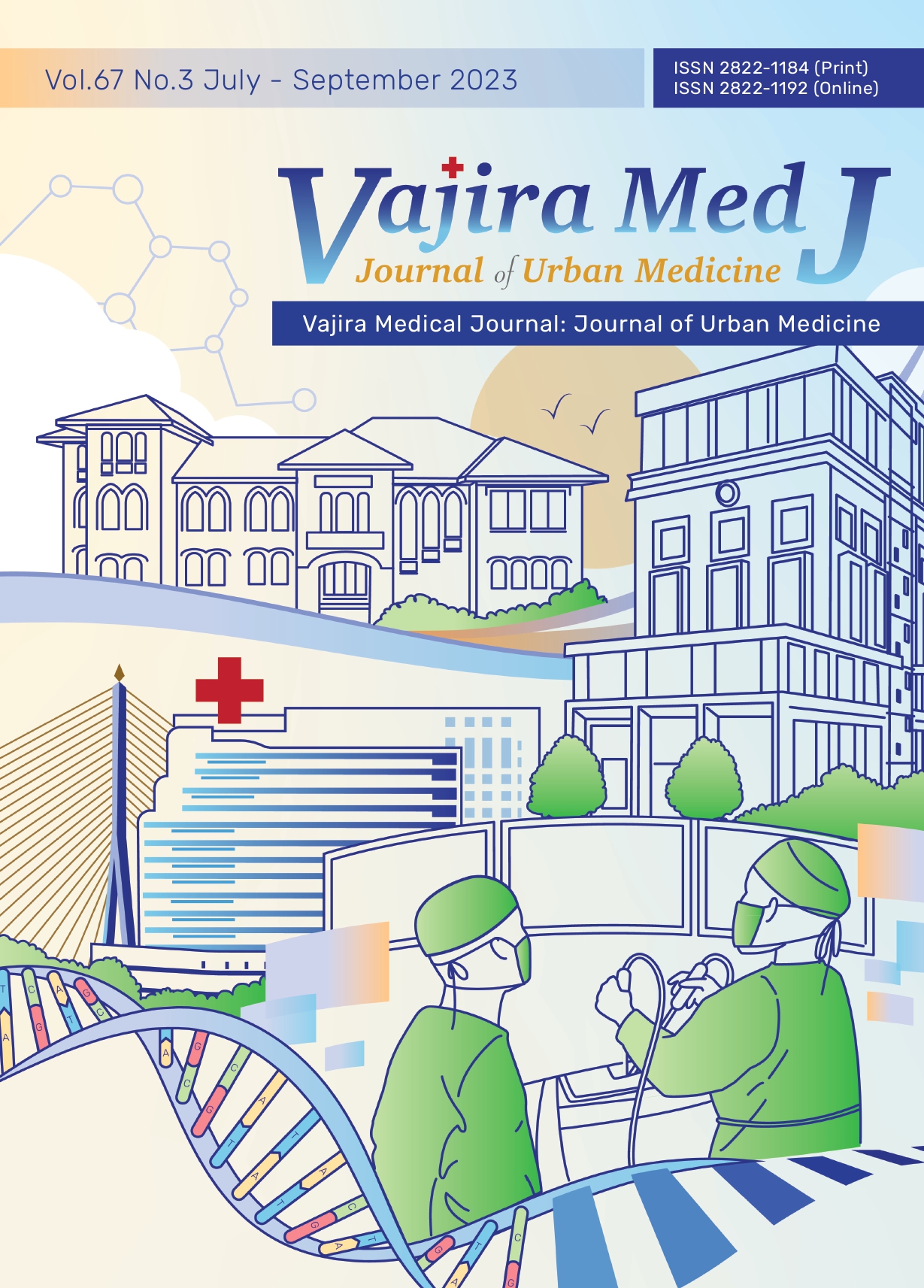Mortality and Outcomes of Very Low Birth Weight Infants in Faculty of Medicine Navamindradhiraj University Mortality and Outcomes of Very Low Birth Weight Infants
Main Article Content
Abstract
OBJECTIVE: To determine the mortality and morbidity rate of very low birth weight infants (VLBW) who were admitted to the neonatal care unit of Faculty of Medicine Vajira Hospital, Navamindradhiraj University.
METHODS: A retrospective review of statistical data from the medical record of VLBW infants who were admitted between January 1, 2014 to December 31, 2020 (7 years). The statistical data include data collected until infants were discharged from hospital.
RESULTS: A total of 217 VLBW infants were analyzed. The mortality rate among VLBW infants during the 7-year study is 12%. The infant’s mortality rates of birth weight (BW) 1,000-1,499 g and 500-999 g were 5% and 25%, respectively. The mean gestational age was 29.4 ± 2.7 weeks, the mean BW was 1079.8 ± 255.9 g . The common morbidities were respiratory distress syndrome (65%), bronchopulmonary dysplasia (34.1%), hemodynamic significant patent ductus arteriosus (41%) and culture positive late onset sepsis (35.9%). On the 28th day after birth, the survival rate of birth weight 1,000-1,499 g was 95.7% and significantly higher than birth weight 500-999 g extremely low birth weight (ELBW) (80.3%). In addition, when comparing BW in two groups, it was found that the mortality and morbidity rate were higher in ELBW group with statistically significant (p-value < 0.001). The trend of mortality rate for VLBW infants were 23.3%, 20.7% and 18.2% in 2015-2017. However, the mortality rate was decreased to 7.9%, 3% and 7.3% in 2018-2020.
CONCLUSION: The mortality and morbidity rates are significantly correlated to BW. The mortality and morbidity rate of VLBW infants tend to decrease each year.
Downloads
Article Details

This work is licensed under a Creative Commons Attribution-NonCommercial-NoDerivatives 4.0 International License.
References
World health organization. Born too soon: the global action report on preterm birth [internet]. 2012 [cited 2022 Sep 25]. Available from: https://www.who.int/publications/i/item/9789241503433
Kiatchoosokun P , Jirapradittha J , Paopongsawan P, Techasatian L, Lumbiganon P, Thepsuthammarat K, et al. Mortality and comorbidities in extremely low birth weight Thai infants: a nationwide data analysis. Children (Basel) 2022;9(12):1825.
Blencowe H, Krasevec J, de Onis M, Black RE, An X, Stevens GA, et al. National, regional, and worldwide estimates of low birthweight in 2015, with trends from 2000: a systematic analysis. Lancet Glob Health 2019;7(7): e849-60.
Klinratree K, Kosarat S, Tantiprabha W. Mortality and short term outcomes of very low birth weight infants in Chiang Mai University Hospital in 2010 and 2015. Thai J Pediatr 2017;56:51-9.
Niemtant Th, Chamnanvanakij S. Outcome of very low birth weight infants: 10-year experiences at Phramongkutklao Hospital. RTA Med J 2015;68(1):27-34.
Thaithumyanon P. Neonatal morbidity and mortality of very low birth weight infants at King Chulalongkorn Memorial Hospital. Chula Med J 2008;52(4):255-64.
Itabashi K, Horiuchi T, Kusuda S, Kabe K, Itani Y, Nakamura T, et al. Mortality rates for extremely low birth weight infants born in Japan in 2005. Pediatrics 2009;123(2):445-50.
Chung SH, Bae CW. Improvement in the survival rates of very low birth weight infants after the establishment of the Korean neonatal network: comparison between the 2000s and 2010s. J Korean Med Sci 2017;32(8):1228-34.
Jeschke E, Biermann A, Günster C, Böhler T, Heller G, Hummler HD, et al. Mortality and major morbidity of very-low-birth-weight infants in Germany 2008-2012: a report based on administrative data. Front Pediatr 2016;4:23.
Stoll BJ, Hansen NI, Bell EF, Shankaran S, Laptook AR, Walsh MC, et al. Neonatal outcomes of extremely preterm infants from the NICHD Neonatal Research Network. Pediatrics 2010;126(3):443-56.
Lee HC, Liu J, Profit J, Hintz SR, Gould JB. Survival without major morbidity among very low birth weight infants in California. Pediatrics 2020;146(1):e20193865.
Chen YY, Wang HP, Chang JT, Chiou YH, Huang YF, Hsieh KS. Perinatal factors in patent ductus arteriosus in very lowbirthweight infants. Pediatr Int 2014;56(1): 72-6.
Nizarali Z, Marques T, Costa C, Barroso R, Cunha M. Patent ductus arteriosus: perinatal risk factors. J Neonatal Biol 2012;1(3):1-3.


